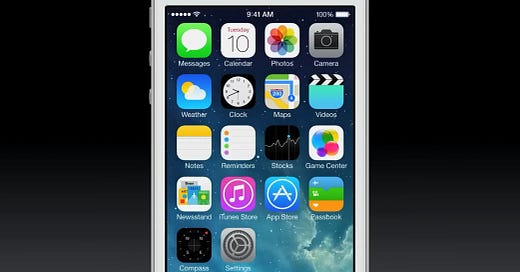Fifteenth #1: On Modernism
How design ideologies continue to constrain our recognition of African creativity
I excavate ideologies of European Modernism, and how they have influenced universal design ideals while also discussing its colonial underpinnings.
I also examine pre-colonial examples of “Modernist” creativity in Africa, and how they demonstrate technological mastery, taking in examples of an ancient chief’s palace in Cameroon to Afro hair braiding
(Some email providers, such as Gmail, may not display this email because it is too long. If this happens to you, use the title link at the top of this message to read this newsletter directly on Substack — Michael)
Arrival of a modern iPhone
Just over 10 years ago, Apple introduced iOS71 for the iPhone at WWDC, its developer’s conference. The audience and press were stunned by the new look of its interface. The simulated visual realism (known as “skeuomorphism”) was unceremoniously dumped in favour of a flatter, almost cartoonish, visual style.
Reports focused on the aesthetics and its new features. The style of its visual design still influences iOS and its competitors today, acting as a catalyst for the progressive transformation of the macOS user experience and design.
Jony Ive, senior vice president of design at Apple at the time, described the changes in an official launch video:
“I think there is a profound and enduring beauty in simplicity. In clarity. In efficiency. True simplicity is derived from so much more than just the absence of clutter and ornamentation. It’s about bringing order to complexity. iOS 7 is a clear representation of these goals.” — Jony Ive, SVP Design, Apple
The goal of realising true simplicity through the elimination of “clutter and ornamentation” is a foundational concept of European Modernism. Look at an iPhone or its operating system, and we can see this is also emblematic of Apple's industrial, visual, and interaction design ethos.
Why does European Modernist design still maintain a singular goal of eliminating ornamentation across so many forms of design today?
This article does not try to determine whether Jony Ive was aware of this association, but the fact that his words closely echo these ideas demands closer examination.
The ideology of European Modernism
Modernism is a wide-ranging arts movement, influencing creative, philosophical, and aesthetic ideals across disciplines as varied as architecture and interiors, as seen in the example of Villa Cavrois (below), to industrial, product, and digital design. Many essays discussing Modernism in the context of digital design tend to focus on its aesthetic qualities. Fewer turn their attention to the reasoning behind its core ideologies.

Modernism continues to influence how “good design” is imagined in our technological age, shaping the look and feel of digital artefacts — so much so that, even in the earlier example of Jony Ive’s description of iOS7 — we can also unconsciously echo its ideology of eliminating the ornament without realising where such ideas originate.
Modernism is a hegemonic reinforcement of what “good design” means, with its aesthetics visually communicating where “good design” originates.
“Modernism ascribed to a Eurocentric modern/colonial order. This order was marked not only by political and economic subjugation but by control of knowledge and aesthetics. Eurocentrism, which attributes universal validity to its notions of beauty, enjoyment, and necessity, is inseparable from the exploitation, denigration, and erasure of others’ worlds of meaning.” — A New Bauhaus? The Debate for a More Inclusive Europe, 2021
Ornament and Crime (1908) by Adolf Loos, a Viennese architect and theorist, was and continues to be, an influential essay in the early European Modernist movement, inspiring the work of architects such as Le Corbusier. One of the central arguments in this text was the rejection of “the ornament” — which Loos argued represented the slow and expensive processes needed to beautify designed artefacts. He felt that these types of crafts represented a hindrance to the progress needed in a Modernist society. So where did the contempt for the ornament originate? Was it simply an aesthetic dislike?
Keep reading with a 7-day free trial
Subscribe to First & Fifteenth to keep reading this post and get 7 days of free access to the full post archives.




